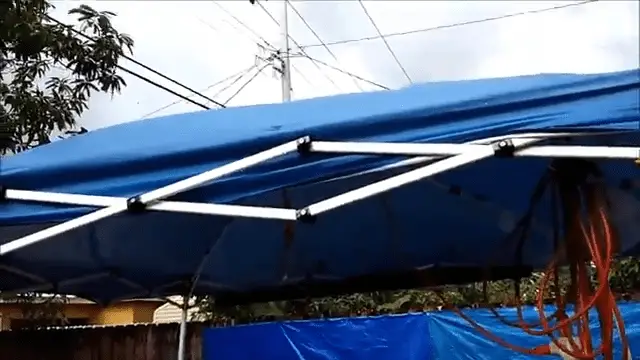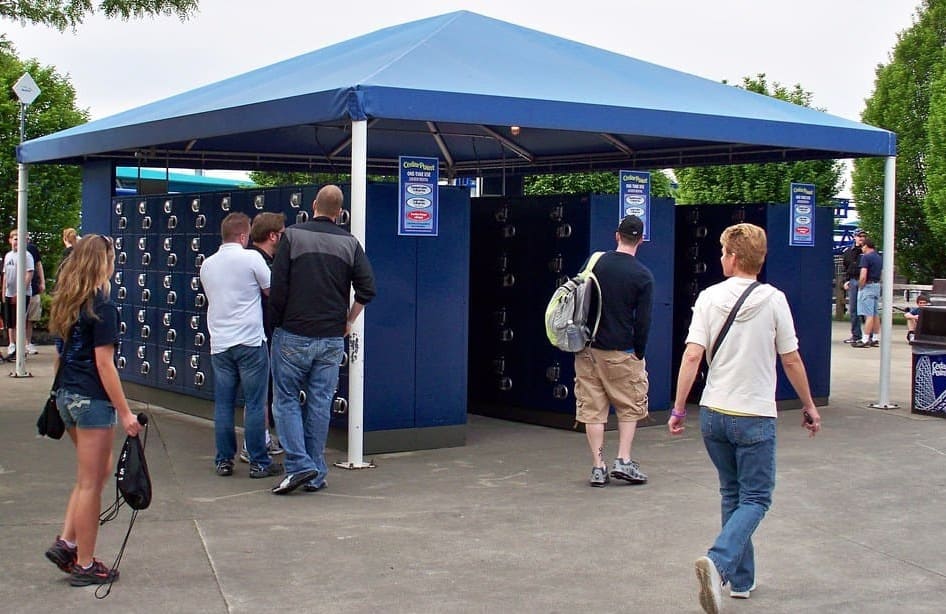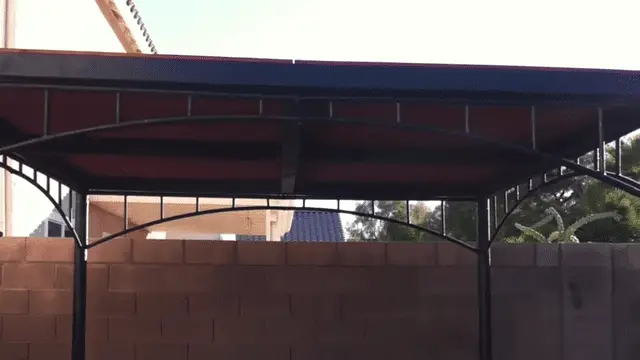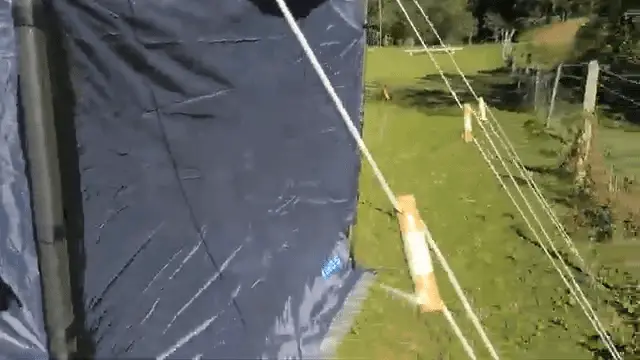How to Strengthen a Pop Up Gazebo. Pop-up gazebos are popular for outdoor events because they provide a sheltered space for people to gather or for goods to be displayed and sold. However, they can be vulnerable to damage from unpredictable weather conditions.
It’s important to ensure your pop-up gazebo is sturdy and secure to prevent it from being blown over by gusts of wind, potentially causing injuries and damage to the structure and anything underneath it.
In this guide, we will provide step-by-step instructions on how to strengthen your pop-up gazebo. We will cover assessing the current state of your pavilion, reinforcing the frame, strengthening the fabric canopy, securing the pavilion, and maintenance and safety tips.
By following these steps, you can ensure that your pop-up gazebo provides a safe and reliable shelter for outdoor events, regardless of the weather.
How to Strengthen a Pop-Up Gazebo: To strengthen a pop-up gazebo, reinforce the frame with additional cross-bracing or metal connectors. Upgrade the canopy fabric to a durable material and secure it tightly. Use heavy-duty stakes or weights for stability. Regularly inspect and maintain the gazebo for longevity.
The Importance of Sturdy and Secure Pop-Up Gazebos for Outdoor Events
A pop-up gazebo is a type of temporary shelter that is easy to set up and take down. It is commonly used in outdoor events such as weddings, parties, and markets to provide a sheltered space for people to gather or for goods to be displayed and sold.
It is crucial to ensure that a pop-up gazebo is sturdy and secure, as it is often used in unpredictable weather conditions. A poorly anchored gazebo can be blown over by strong winds, causing damage to the structure and potentially injuring people or damaging objects underneath it.
Regularly checking the gazebo’s condition and anchoring it properly using weights or stakes can prevent these incidents, ensuring a safe and reliable shelter for any outdoor event.
Why a Sturdy Pop-Up Gazebo is Crucial for Different Weather Conditions”
A pop-up gazebo is designed to provide shelter from different weather conditions. It can protect you from the sun on a hot day, provide shade on a bright day, and keep you dry on a rainy day.
The gazebo canopy is usually made of waterproof material that can withstand rain and prevent water from seeping. It can also protect you from strong winds, which can be dangerous if not appropriately sheltered.
Additionally, it can provide shade and protection from UV rays on a hot day. It’s important to ensure your pop-up gazebo is sturdy and secure enough to withstand different weather conditions to protect you and your belongings.
How to Strengthen a Pop Up Gazebo ( step by step)
Here are the steps to strengthen a pop-up gazebo:
- Check the frame for damage or wear and tear.
- Inspect the joints and connectors for looseness or corrosion.
- Reinforce the joints and connections with metal brackets.
- Add crossbars to increase stability.
- Replace any damaged or worn parts.
- Apply a waterproofing solution to the canopy to protect it from water damage.
- Use additional straps to secure the canopy to the frame.
- Replace any torn or damaged sections of the canopy.
- Use ground stakes or weights to anchor the gazebo to the ground.
- Consider using guy ropes for extra stability in windy conditions.
- Regularly maintain and inspect the gazebo for safety.
Assessing the Current State of Your Gazebo
Before strengthening your pop-up gazebo, you should assess its current state to identify any weaknesses or damage. Check the metal frame for any signs of rust, cracks, or bends. Inspect the fabric canopy for any holes, tears, or discoloration. If you notice any problems, address them before reinforcing your gazebo.
Strengthening a damaged or weakened gazebo could cause further damage or even make it more dangerous. By assessing the current state of your gazebo, you can ensure that it’s safe and stable before you start any strengthening work.
Inspect Gazebo Frame for Damage and Wear and Tear
Before using a gazebo, it’s important to inspect the frame for any damage or signs of wear and tear. Look for cracks, rust, or any other types of damage that could compromise the structure’s stability.
If you notice any issues, it’s best to address them before using the gazebo to ensure the safety of everyone who will be using it. Regular inspections can help you identify potential problems early on and allow you to take necessary measures to keep the gazebo in good condition.
Check Joints and Connectors for Looseness or Corrosion in Gazebo
When inspecting a gazebo, it’s important to pay attention to the joints and connectors as well. Look for any signs of looseness or corrosion that could compromise the stability of the structure. Loose joints or connectors can cause the gazebo to wobble or even collapse, posing a risk to those using it.
If you notice any issues, tighten the screws or replace the connectors as necessary. Regular checks of the joints and connectors can help you identify and address any problems before they become more serious, ensuring the safety and longevity of your gazebo.
Reinforcing the frame of a gazebo

Reinforcing the frame of a gazebo can be necessary to ensure its structural integrity and longevity. This can involve adding additional supports or bracing to weak areas of the frame or replacing damaged components.
Reinforcing the frame may also be necessary if you plan to use the gazebo in areas with harsh weather conditions or for heavy use, such as hosting large gatherings or using it as a permanent outdoor living space.
Consulting with a professional or a gazebo manufacturer can help you determine the best approach to reinforce your gazebo frame to ensure its safety and longevity.
Reinforcing Joints and Connections
Using metal brackets is a common method to reinforce the joints and connections in a gazebo frame. Metal brackets can provide additional support and stability to weak or loose joints, preventing them from becoming a safety hazard. When using metal brackets, ensure they are appropriately sized and designed for the joint or connection you reinforce.
Improperly installed or sized metal brackets can do more harm than good and compromise the structure’s integrity. If you are unsure about the appropriate use of metal brackets, consult a professional or refer to the manufacturer’s recommendations.
Increasing the Stability of Gazebo with Crossbars
Adding crossbars to a gazebo can increase its stability and prevent it from swaying or wobbling during use. Crossbars are typically placed diagonally between two or more vertical posts, creating a triangular shape that distributes weight evenly and provides additional support.
When adding crossbars, ensure they are appropriately sized and securely fastened to the vertical posts to prevent them from becoming a safety hazard. Adding crossbars can be a simple and effective way to increase the stability of your gazebo, providing you and your guests with a safe and enjoyable outdoor space.
Replacing Damaged or Worn Parts
Regular inspections of your gazebo can help you identify damaged or worn parts that need to be replaced to ensure their safety and longevity. Common parts needing replacement over time include roof panels, screens, fabric canopies, and structural components like poles and connectors.
When replacing parts, ensure that they are the correct size and designed for your gazebo’s specific make and model. Incompatible or poorly fitting parts can compromise the gazebo’s stability and safety.
Replacing damaged or worn parts as soon as they are identified can help prevent more significant problems and ensure that your gazebo remains a safe and enjoyable outdoor space for years.
Protecting and Strengthening

The fabric canopy of a gazebo is a critical component that protects against harmful UV rays and provides shade and comfort for users. Over time, the fabric may become weakened by weather exposure or heavy use, compromising its protective properties.
To strengthen the fabric canopy, you can add a protective layer or coating, such as a UV-resistant spray, to prolong its lifespan and protect it against harmful elements. Additionally, if the fabric is sagging or showing signs of wear, it may need to be replaced entirely to ensure proper protection and stability.
Strengthening the fabric canopy can enhance the gazebo’s functionality and ensure a comfortable and safe outdoor space for you and your guests.
Protecting Your Gazebos Fabric Canopy from Water Damage
To protect your gazebo’s fabric canopy from water damage, it’s important to apply a waterproofing solution. This will create a barrier on the fabric’s surface, preventing water from seeping through and causing damage. Waterproofing solutions, including sprays and liquids, come in various forms and are easy to apply.
Regularly applying a waterproofing solution to your gazebo’s canopy ensures that it remains in good condition and continues to provide shade and protection for years to come.
Securing Your Gazebos Fabric Canopy with Additional Straps
To ensure that your gazebo’s fabric canopy stays in place during windy or stormy weather, it’s essential to use additional straps to secure it to the frame. This will help prevent the canopy from becoming dislodged or damaged and provide added stability and support to the gazebo structure.
Straps can be easily attached to the canopy corners and tied or buckled to the gazebo frame. This simple precaution allows you to enjoy your gazebo without worrying about potential damage or safety concerns caused by unsecured canopies.
Replacing Torn or Damaged Sections of Your Gazebos Fabric Canopy

If your gazebo’s fabric canopy has torn or damaged sections, it’s essential to replace them as soon as possible. Torn or damaged sections of the canopy can compromise its protective properties, leaving users vulnerable to harmful UV rays and other outdoor elements.
In addition, damaged sections can weaken the overall structure of the canopy, leading to further damage or safety hazards. To replace torn or damaged sections, replace the damaged portion with a new piece of fabric that matches the original.
This will help ensure that your gazebo continues providing adequate shade and protection for years.
Securing Your Gazebo for Safety and Stability
To ensure the safety and stability of your pavilion, it’s essential to properly secure it to the ground. This can be done by using stakes or anchors to secure the legs of the pavilion to the ground.
In addition, adding sandbags or weights to the corners can provide stability during windy or stormy weather. By taking these precautions, you can enjoy your gazebo with the peace of mind that it is securely anchored and safe for use.
Anchoring Your Gazebo with Ground Stakes or Weights for Stability
Ground stakes or weights are practical tools for anchoring your gazebo to the ground and ensuring stability. Stakes can be driven into the ground through the pavilion’s legs and then secured in place with ropes or straps.
This will prevent the gazebo from shifting or toppling over during windy or stormy weather. Alternatively, sandbags or weights can be placed on the corners of the pavilion to provide added stability.
Using ground stakes or weights to anchor your gazebo, you can enjoy the benefits of outdoor living without worrying about safety or damage concerns.
Why Using Guy Ropes is Important for Adding Extra Stability to Outdoor Structures in Windy Conditions

When setting up a tent, canopy, or any other structure that needs to be secured, it’s important to consider the weather conditions that may affect it. In windy conditions, it’s essential to ensure that your structure stays put.
One way to achieve this is by using guy ropes. Guy ropes attach to the corners or edges of your structure and anchor it to the ground.
This helps to add extra stability, preventing your structure from being blown over or damaged by strong gusts of wind. So, if you plan to set up a structure outdoors, consider using guy ropes to ensure it stays safe and secure in all types of weather.
Safety and maintenance
Maintenance and safety are two essential aspects to consider when owning and operating any equipment or machinery. Regular maintenance can help to keep your equipment in good condition, reduce the risk of breakdowns, and prolong its lifespan.
On the other hand, prioritizing safety measures can help prevent accidents and injuries, ensuring that everyone who comes into contact with the equipment or machinery is protected.
By prioritizing maintenance and safety, you can help ensure that your equipment operates effectively and safely, minimizing the risk of damage, downtime, or harm to those around it.
The Importance of Regular Gazebo Maintenance for Long-Term Durability and Enjoyment
Regular maintenance is crucial for keeping a gazebo in good condition. Gazebo maintenance involves several tasks, such as cleaning, repairing, and checking for any signs of wear and tear. Cleaning the pavilion regularly helps to prevent dirt and debris from accumulating, which can lead to mold growth and the rotting of the wood.
Repairing damaged parts, such as broken roof shingles or boards, is also essential to prevent further damage and ensure the gazebo is safe to use. Checking for signs of wear and tear, such as cracks or splits in the wood, rust into metal parts, or loosening of joints, is also necessary to address any issues before they worsen.
Regularly maintaining your gazebo can extend its lifespan, prevent costly repairs, and ensure it remains an enjoyable outdoor space for years to come.
Essential Safety Tips to Keep in Mind
When it comes to using a gazebo, safety should be a top priority. Here are some essential safety tips to keep in mind:
- Do not leave the gazebo up in extreme weather conditions such as strong winds, heavy rain, or snow. These conditions can cause damage to the pavilion or even lead to it becoming airborne, creating a safety hazard.
- Ensure the gazebo is adequately secured to the ground with stakes, weights, or guy ropes to prevent it from tipping over or being blown away by strong wind gusts.
- Avoid using open flames or heaters inside the pavilion, as this can increase the risk of fire or carbon monoxide poisoning.
- Keep the gazebo clean and free of clutter or debris that could cause tripping hazards or obstruct walkways.
- If the pavilion is made of metal, be cautious of touching it during hot weather as it can become boiling and potentially cause burns.
By following these safety tips, you can help ensure that your gazebo is a safe and enjoyable outdoor space for all to use.
FAQs
Q.1 How do I make my gazebo more stable?
To keep your gazebo in place, you can use tent pegs and rope. Most gazebos come with ropes attached, which you can use to secure them. You can also tie some extra rope to the frame for added stability.
Q.2 Can a gazebo withstand wind?
Gazebos are okay to use when it’s a little windy, but too much wind can be dangerous. Professional gazebos are designed to handle wind gusts up to 40mph, but garden gazebos are unsafe to use when windy and the wind speed is 27 mph or higher.
Q.3 How do I stop my gazebo from bending?
To make your gazebo strong and safe, push stakes or pegs into the ground at each corner of the gazebo. Then, use a strong rope or cord to connect each stake and leg of the gazebo together. You can also tie the rope to the corners of the inner roof canopy by threading it up the corners of the gazebo.
Conclusion
The article discusses the importance of ensuring a pop-up gazebo is sturdy and secure, as it is often used in unpredictable weather conditions. It recommends inspecting the gazebo frame for damage or wear and tear, reinforcing the joints and connections with metal brackets and crossbars, and strengthening the fabric canopy with a waterproofing solution and additional straps.
The article also advises using ground stakes or weights to anchor the gazebo to the ground and considering guy ropes for extra stability in windy conditions. Lastly, it emphasizes the importance of regular maintenance and safety checks to ensure the gazebo remains safe and reliable.
We hope you will know how to strengthen a popup gazebo by reading this comprehensive guide. If you have any questions, feel free to comment below!


